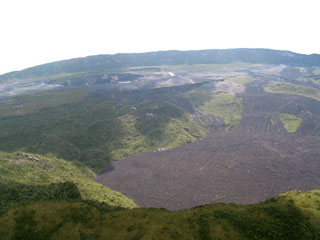Report on Nyamulagira (DR Congo) — July 1992
Bulletin of the Global Volcanism Network, vol. 17, no. 7 (July 1992)
Managing Editor: Lindsay McClelland.
Nyamulagira (DR Congo) NE-flank fissures continue to produce lava
Please cite this report as:
Global Volcanism Program, 1992. Report on Nyamulagira (DR Congo) (McClelland, L., ed.). Bulletin of the Global Volcanism Network, 17:7. Smithsonian Institution. https://doi.org/10.5479/si.GVP.BGVN199207-223020
Nyamulagira
DR Congo
1.408°S, 29.2°E; summit elev. 3058 m
All times are local (unless otherwise noted)
The eruption . . . was continuing at the end of July 1992. A new vent (no. 19) opened during the night of 4-5 July (figure 12). For several days, the new vent ejected mainly ash and bombs without a significant lava flow, then was the source of intermittent fountaining until 15 July. Several hundred meters E of cone 19, another vent (no. 20) became active on 14 July, producing a voluminous lava flow for the first two days, and high lava fountains that rose 50 m on 21 July. Another new vent (no. 21) developed SE of cone 19 on 19 July, feeding a lava fountain that was visible 5 km away. The amplitude of microtremors remained high through July, suggesting to geologists that ascent of magma from a deep reservoir continued at a significant rate.
Geological Summary. Africa's most active volcano, Nyamulagira (also known as Nyamuragira), is a massive high-potassium basaltic shield about 25 km N of Lake Kivu and 13 km NNW of the steep-sided Nyiragongo volcano. The summit is truncated by a small 2 x 2.3 km caldera that has walls up to about 100 m high. Documented eruptions have occurred within the summit caldera, as well as from the numerous flank fissures and cinder cones. A lava lake in the summit crater, active since at least 1921, drained in 1938, at the time of a major flank eruption. Recent lava flows extend down the flanks more than 30 km from the summit as far as Lake Kivu; extensive lava flows from this volcano have covered 1,500 km2 of the western branch of the East African Rift.
Information Contacts: N. Zana, CRSN, Bukavu.

